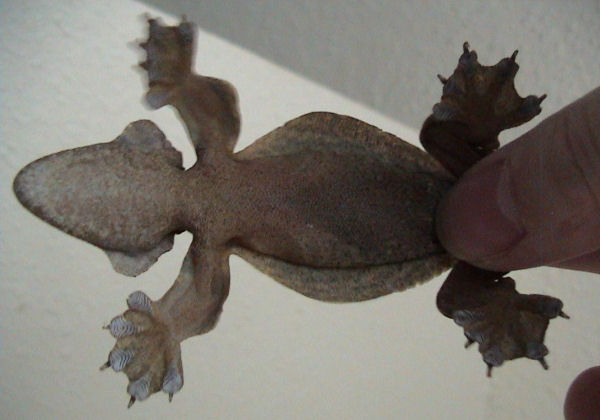Ptychozoon kuhli on:
[Wikipedia]
[Google]
[Amazon]
''Gekko kuhli'', commonly known as Kuhl's flying gecko, Kuhl's parachute gecko, or the gliding gecko, is a

, Pet Supplies Comparison Shopping. Awesome Pet Library. Retrieved January 14, 2011. "As with most tree dwelling or arboreal geckos, it is best not to touch or handle these geckos frequently. Their skin is sensitive and can be damaged easily."
species
In biology, a species is the basic unit of classification and a taxonomic rank of an organism, as well as a unit of biodiversity. A species is often defined as the largest group of organisms in which any two individuals of the appropriate s ...
of lizard in the family
Family (from la, familia) is a group of people related either by consanguinity (by recognized birth) or affinity (by marriage or other relationship). The purpose of the family is to maintain the well-being of its members and of society. Idea ...
Gekkonidae
Gekkonidae (the common geckos) is the largest family of geckos, containing over 950 described species in 64 genera. Members of the Gekkonidae comprise many of the most widespread gecko species, including house geckos ('' Hemidactylus''), tokay g ...
. The species is found in Southeast Asia
Southeast Asia, also spelled South East Asia and South-East Asia, and also known as Southeastern Asia, South-eastern Asia or SEA, is the geographical south-eastern region of Asia, consisting of the regions that are situated south of mainlan ...
.
Etymology
The specific name, ''kuhli'', is in honor of Germanzoologist
Zoology ()The pronunciation of zoology as is usually regarded as nonstandard, though it is not uncommon. is the branch of biology that studies the animal kingdom, including the structure, embryology, evolution, classification, habits, and d ...
Heinrich Kuhl
Heinrich Kuhl (17 September 1797 – 14 September 1821) was a German naturalist and zoologist.
Kuhl was born in Hanau (Hesse, Germany). Between 1817 and 1820, he was the assistant of professor Th. van Swinderen, docent natural history at the ...
.
Description
''G. kuhli'' has adaptations to its skin, including flaps on either side of its body, webbed feet, and a flattened tail to allow it to glide over short distances. This gecko has a remarkable camouflage. The flaps of skin along its sides help it blend with tree bark. Often, its eyes are the only way to distinguish it from its surroundings. This use of camouflage by ''G. kuhli'' has caused need for some other adaptions to protect it from the increased UV exposure. Despite being nocturnal, they are considered heliothermic because of the extended sun exposure they receive while resting during the day. This increased UV exposure has led to the adaption of pigmented internal organs to protect the lizards more important organs from UV damage. Kuhl's flying gecko, like many other gecko species, has evolved intricate toe pads with microscopic hairs that can adhere to nearly any surface, including glass.
Geographic range
''G. kuhli'' is found in the Malay Peninsula (southernThailand
Thailand ( ), historically known as Siam () and officially the Kingdom of Thailand, is a country in Southeast Asia, located at the centre of the Indochinese Peninsula, spanning , with a population of almost 70 million. The country is b ...
, Malaysia
Malaysia ( ; ) is a country in Southeast Asia. The federation, federal constitutional monarchy consists of States and federal territories of Malaysia, thirteen states and three federal territories, separated by the South China Sea into two r ...
, Singapore
Singapore (), officially the Republic of Singapore, is a sovereign island country and city-state in maritime Southeast Asia. It lies about one degree of latitude () north of the equator, off the southern tip of the Malay Peninsula, bor ...
) and many adjacent islands and in the Greater Sunda Islands
The Greater Sunda Islands ( Indonesian and Malay: ''Kepulauan Sunda Besar'') are four tropical islands situated within Indonesian Archipelago, in the Pacific Ocean. The islands, Borneo, Java, Sulawesi and Sumatra, are internationally recognised ...
, including the larger islands (Sumatra, Java, Borneo, and Sulawesi) and many smaller ones. Its presence in Myanmar
Myanmar, ; UK pronunciations: US pronunciations incl. . Note: Wikipedia's IPA conventions require indicating /r/ even in British English although only some British English speakers pronounce r at the end of syllables. As John Wells explai ...
and the Nicobar Islands (India) is unconfirmed.
As a pet
The common flying gecko requires, among other things, a terrarium of at least 20 gallons (57–76 litres), preferably tall rather than long, and careful handling. It should be handled as little as possible, due to possible damage to its skin.Flying Geckos - Facts, Pet Supplies Comparison Shopping. Awesome Pet Library. Retrieved January 14, 2011. "As with most tree dwelling or arboreal geckos, it is best not to touch or handle these geckos frequently. Their skin is sensitive and can be damaged easily."
References
Further reading
* Brown, Rafe M.; Ferner, John W.; Diesmos, Arvin C. (1997). "Definition of the Philippine Parachute Gecko, ''Ptychozoon intermedium'' Taylor 1915 (Reptilia: Squamata: Gekkonidae): Redescription, designation of a neotype, and comparisons with related species". ''Herpetologica'' 53 (3): 357–373. *Brown, Rafe M. (1999). "New species of parachute gecko (Squamata: Gekkonidae: genus ''Ptychozoon'') from northeastern Thailand and central Vietnam". ''Copeia'' 1999 (4): 990–1001. * Mertens, Robert; Senfft, Walter (1929). "''Aus dem Leben des Faltengeckos'' (Ptychozoon kuhli ''Stejneger'')". ''Natur und Museum'' 59 (4): 218–224. (in German). * Stejneger L (1902). "''Ptychozoon kuhli'', a new name for ''P. homalocephalum'' ". ''Proc. Biol. Soc. Washington'' 15: 37. *Griffing, A. H., Gamble, T., & Bauer, A. M. (2020). Distinct patterns of pigment development underlie convergent hyperpigmentation between nocturnal and diurnal geckos (squamata: gekkota). Bmc Evolutionary Biology, 20(1). https://doi.org/10.1186/s12862-020-01604-9External links
{{Taxonbar, from=Q111042993, from2=Q2700890 Gekko Lizards of Asia Fauna of Southeast Asia Reptiles of Borneo Reptiles of Brunei Reptiles of India Geckos of Indonesia Geckos of Malaysia Reptiles of Singapore Geckos of Thailand Taxa named by Leonhard Stejneger Reptiles described in 1902 Gliding animals